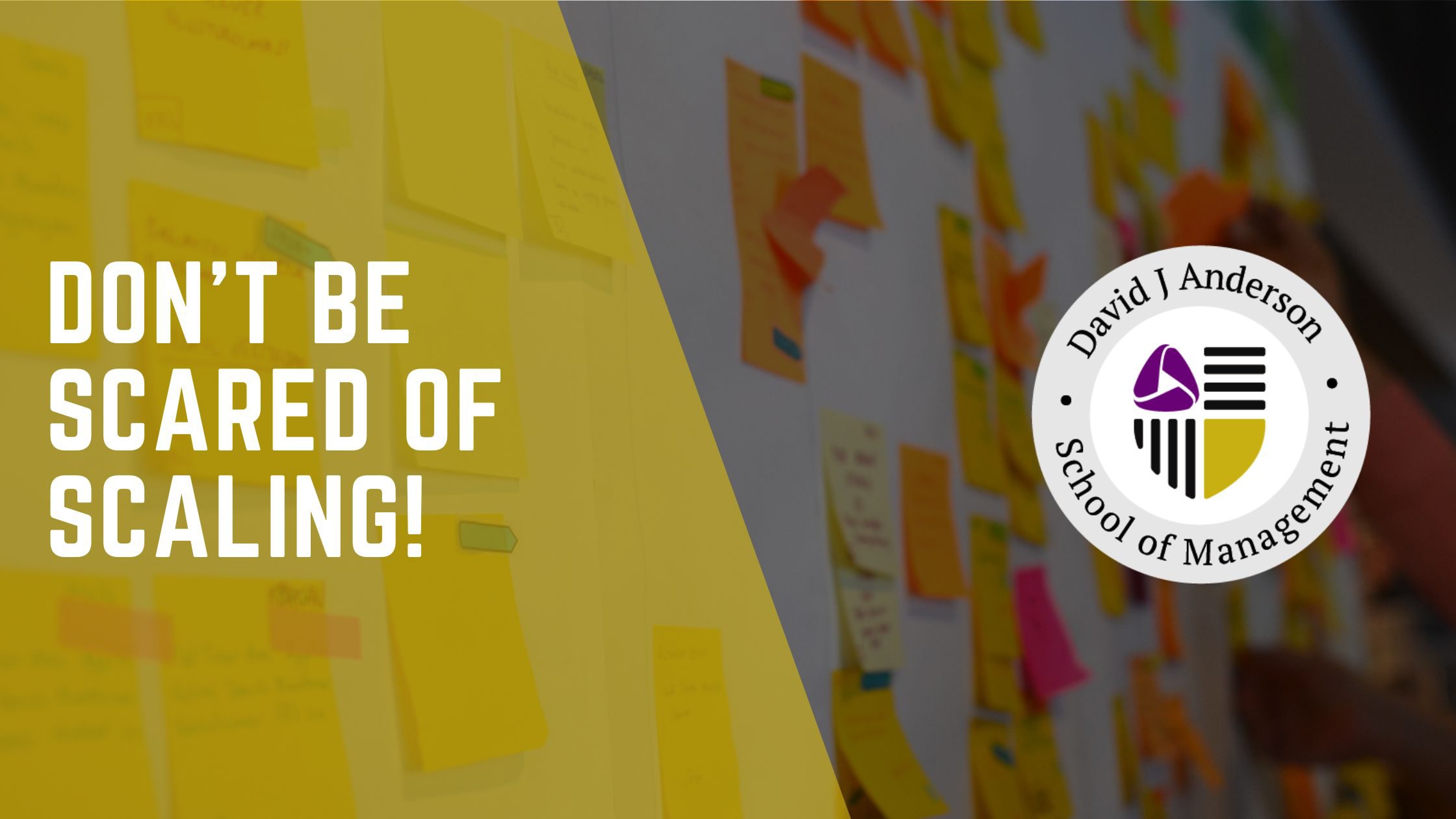A Brief History of Kanban for Knowledge Work
Success has many fathers! Recently, there has been some content published elsewhere on the web that seeks to re-write the history of the adaptation of kanban systems into the field of creative knowledge work. The individuals publishing these alternative versions of history are generally doing it for self-serving reasons or in some cases as deliberate misinformation to try and undermine my business. To put the record straight, I’ve compiled this definitive history…
A History of Kanban for Creative Knowledge work
October 2004
Dragos Dumitriu, manager XIT Sustaining Engineering at Microsoft, asks me to help him. I design a pull system for Dragos’ group and coach him on how to introduce it. He “sells’ the idea to his bosses and his 4 product managers who act as his customers. The pull system was implemented on Microsoft Product Studio (a forerunner of Team Foundation Server). There was no physical board. The engineering team was offshore in Hyderabad, India. The system implemented was inspired by Theory of Constraints Drum-Buffer-Rope and worked on the assumption that Test was the bottleneck.
Winter 2005
Donald Reinertsen after watching me present my flow and FDD material at a conference in Chicago, follows me home to Seattle and visits me in the cafe of Building 25 on the Microsoft campus. He persuades me to try kanban systems. I decide to revisit the XIT implementation as a kanban system and discover that little would change other than perhaps the WIP limits would be slightly different. I find kanban systems easier to explain to people than DBR and Dragos and I start referring to the XIT implementation as a virtual kanban system. I present it this way at another conference in Chicago the following year.
October 2005
The XIT Sustaining Engineering study is presented at TOCICO in Barcelona and published as a white paper by Microsoft.
Winter 2006
I present the completed XIT story as a virtual kanban system implementation at the same Chicago conference, Don Reinertsen and I had presented the previous year. This is the first public presentation of kanban systems used in a knowledge work setting. At this point only Dragos Dumitriu and I had been involved.
Summer 2006
Some people read and implement copies of the Microsoft XIT solution. The most notable of these was Eric Landes at Robert Bosch who copies it almost exactly for use with an intranet website maintenance team.
September 2006
I arrive at Corbis as the Senior Director for Software Engineering. The software maintenance process is badly broken and I work with Rick Garber, the manager of the process improvement team, to design a kanban system to replace the existing projec-centric approach to minor application upgrades. We socialize the design with stakeholders including Drew McLean, a VP at Corbis, who suggests the Expedite capability, adding the first alternative class of service to a kanban system for knowledge work. Darren Davis is the development manager for maintenance and Diana Kolomiyets is the project manager. They take control of the kanban implementation in November 2006. Darren takes charge of standup meetings and Diana runs the replenishment meetings every week and plans and coordinates the releases every two weeks.
December 2006
We institute operations review IT department wide at Corbis. Results from the first kanban system implementation are presented by Darren Davis during the review
January 2007
Darren Davis suggests that after a series of successful releases from the maintenance process improvements seem to be stagnating and there appears to be so much variation in flow that no one can understand what to do next. He suggests that we should visualize the workflow using a card wall implemented on a white board across the hallway from his cubicle. The idea came from one of his team members. So a board goes up on the wall.
Winter 2007
Through January to March the board on the wall helps with further improvements. Capacity is set aside for internal demand. A WIP limit of 2 is established for green tickets. I notice a trending pattern for urgent work with externally fixed dates such as March 31st. I suggest we offer this “fixed date” concept as a class of service. What we now recognize as the Kanban Method with its six practices and risks visualized and addressed using capacity allocation and classes of service emerges by end of winter 2007.
I approached Corey Ladas whom I had known as part of the Engineering Excellence group at Microsoft and I persuade him to join Corbis as the process coach for Kanban. Corey is excited by what we are doing and joins enthusiastic to help us scale it across the organization.
April 2007
I meet with the incoming CEO of Corbis who asks why if the maintenance process is working so well, we aren’t using the same process across all of IT. I agree with him and we start roll out Kanban across the project portfolio. Our Digital Asset Management (DAM) project which had already adopted Scrum, adopts Kanban under Corey’s guidance. The first two-tiered kanban board with swim lanes emerges. We start planning a $10million+ ERP project.
May 2007
Dan Vacanti arrives as the development manager for the ERP project. Dan and I have history together since 2000 but Dan has until this point not worked with Kanban. He works together with me and Corey Ladas to design the process for the project. We roll the staff off the DAM project onto the ERP project and the two-tiered kanban board innovation comes with them.
June 2007
Rick Garber and I present the full Corbis Kanban implementation at a Donald Reinertsen Lean New Product Development conference in Chicago at the Hyatt McCormick Place. There are only 55 people in the audience including Mary Poppendieck. This is the first presentation of what we now know as the Kanban Method complete with classes of service, lead time histogram metrics, operations review, “after meeting” kaizen events and so forth.
August 2007
Having failed to get on the regular program for Agile 2007 in Washington DC, I make use of the projector in the CwaC (Conference within a Conference) open space to give the same presentation Rick Garber and I gave in Chicago. There are 25 people in the audience including Karl Scotland, Olav Maassen, Arlo Belshee, Kenji Hiranabe and others. The following day Karl Scotland, Joe Arnold and Aaron Sanders all from Yahoo! approach me and tell me that my evolutionary approach to change and alternative path to agility using virtual kanban systems message is appealing to them. They explain they have to implement Scrum at Yahoo! and that several/many groups are resisting. They want to try Kanban with those groups. They ask that we setup a Yahoo! discussion group for them to share their experiences. The kanbandev group on Yahoo! is born that day.
January 2008
Jim Benson, Corey Ladas and I form Modus Cooperandi, a management consulting firm intent on developing a practice around evolutionary change and improved service delivery agility. We adopt the slogan “performance through collaboration” which is mildly influenced by Audi’s “Vorsprung durch Tecknik.” We engage a former Microsoft colleague of mine, Kim Tapia-St.Amant to design the roundel logo featuring the hand shake of collaboration.
August 2008
Corey Ladas presents more detailed Kanban implementation scenarios at the Agile 2008 conference along with a paper describing these. One half of the presentation focuses on Kanban applied to teams and projects using Scrum. This is the foundation of what became known as Scrumban
September 2008
I start David J. Anderson & Associates leaving Jim and Corey to continue with Modus Cooperandi. Dan Vacanti joins me soon afterward as my first associate.
January 2009
Modus Cooperandi Press publishes Corey Ladas’ book, Scrumban based mostly around a series of blog posts he’d written on the topic of evolving from Scrum using Kanban.
May 2009
The first Lean Kanban conference is held in Miami. The idea for the event was first proposed on the kanbandev list in a conversation on the list between me, Chris Matts and Joshua Kerievsky in the fall of 2008. What was originally envisaged as a pure Kanban event was extended to include other Lean content because Alan Shalloway wanted to include Dean Leffingwell. There was a pre-conference day meeting which resulted in the formation of the Lean Software & Systems Consortium that later became the Lean Systems Society.
The same month Jim Benson and I meet over a cup of chai in the Ballard neighborhood of Seattle primarily to reflect on the Miami conference which neither Jim nor Corey had attended. We come on to discuss how Kanban for personal use is different from corporate workflow usage – what we now refer to as Service Delivery Kanban. We have seen personal usage emerge in various places around the world including the Modus Cooperandi office. I encourage Jim to blog about it.
July 2009
Jim Benson launches Personal Kanban as a series of 12 blog posts.
October 2009
Jim Benson launches PersonalKanban.com
May 2010
Kanban – Successful Evolutionary Change for your Technology Business, is published by my imprint, Blue Hole Press, and becomes the best and most complete reference to implementing kanban systems in creative and knowledge worker businesses. It has gone on to sell over 40,000 copies in 4 years and is translated into 8 languages with several more pending.
January 2011
Modus Cooperandi Press publishes, Personal Kanban – Mapping Work|Navigating Life by Jim Benson and Tonianne DeMaria Barry
June 2011
The first Kanban Leadership Retreat is held in Reykjavik, Iceland. The invitee list includes all attendees of my Kanban Coaching Masterclass, and a collection of business partners who marketed and co-trained Kanban classes around the world, and some of the principals from firms making Kanban software tools. One outcome of this meeting was an agreement to create a trade association to market high quality, standardized Kanban training around the world.
November 2011
Lean Kanban University Inc had been formed as a joint venture with Alan Shalloway earlier in the year. It original intent was as a portal to promote Kanban training. We now agreed that this brand and site will become the home of the trade association and as part of the changes, David J. Anderson & Associates agrees to buy 30% of the firm from Alan Shalloway’s Net Objectives. 16 founding member firms join and pay their fees as charter members.
February 2012
At a meeting of founding members in Utrecht, Netherlands, the governing charter for the Lean Kanban University trade association is agreed and the organization is launched publicly.
March 2013
Lean Kanban University requires an injection of capital to continue its development. Alan Shalloway chooses not to invest and agrees to sell his remaining 20% of Lean Kanban University Inc., to David J. Anderson & Associates. The firm changes its name to Lean Kanban Inc and is merged with the Lean Kanban conference business. Its incorporation is moved from the state of Delaware to the state of Washington.
April 2013
After 3 years using our conference to promote the Lean Software & Systems Consortium, we return the event to its original brand adding a region designation to illustrate that it is now part of a global series of events, Lean Kanban North America.
Some Observations
There are many well known names in our community today who are not mentioned in this history. This is because they did not play any significant role in the development of Kanban to the point where the book was published and the method became well known in the Agile and CMMI communities.
Jim Benson doesn’t appear in the story until 2008. Prior to this Jim was a drinking buddy of mine throughout these early years. He was aware of the development of Kanban on a weekly basis. Jim met Corey Ladas through me. Jim went on to document and evangelize Personal Kanban and he deserves the credit for popularizing this derivative concept. Daniel Vacanti does not appear in the story until mid-2007. His main expertise and experience has been using kanban systems on large corporate projects and his own business now focuses on this. Alan Shalloway played only a peripheral role being involved in the original Lean Kanban conference as a Lean Software Development presenter and as a founder of the Lean Software & Systems Consortium and a joint venture partner in the early days of Lean Kanban University. Jim, Corey nor Alan have every participated in a Kanban Leadership Retreat. There are some others with web sites who lay claim to having invented derivative versions of Kanban. Some of these people have never been involved in our community, have never attended a Kanban training or conference. Their work appears to be largely derived from reading or viewing content created by people I have mentioned here or others in our community, too numerous to mention, who have come along since 2010.
Many people have shaped how Kanban has developed and how we teach it. Some of them don’t even know how they contributed, they simply asked the right questions at the right time, or produced similar validating results coming from other motivations. For me the most influential people through until 2010 when the Kanban book was published in addition to those I’ve already mentioned were: Arlo Belshee, Joshua Kerievsky, Rob Hathaway, Jean Tabaka, Ron Jeffries, Norbert Winklareth, Rick Simmons, Alisson Vale, Steve Ried, Janice Linden-Reed, Chris Hefley, Siddarta Govindaraj, Chris Shinkle, Eric Willeke, Mike Fitterman, Chris Matts, Jasper Sonnevelt, Mattias Skarin, Patrick Steyaert, David Draper, Benjamin Mitchell, David Joyce, Christoph Louvion, Linda Cook, Max Keeler, and David Laribee.
You need to have a long memory to recognize some of these names from our community. Also some very notable names and currently great contributors weren’t an active part of the community in those days or had no significant influence on me and the definition of the Kanban Method at the time.
Success has many fathers. There are many who want to lay some claim to having invented or created the Kanban Method or some variant of it. The reality is that the idea to adopt virtual kanban systems from manufacturing to software engineering came from Don Reinertsen. Dragos Dumitriu and I implemented it. Through further experimentation we discovered that the use of virtual kanban systems could be even more powerful when synthesized with other practices. From that the Kanban Method emerged.
The use of kanban systems in knowledge work came from only one source and it is those people, me, Dragos, Don Reinertsen who have shared our experiences and collaborated to build a community and a market that serves a broad audience and has brought great value to many throughout the world. There are others who would wish to bask in the limelight – some are more deserving of this than others. So I invite you to decide for yourself who makes valid claims to be a father of these ideas and this movement!




